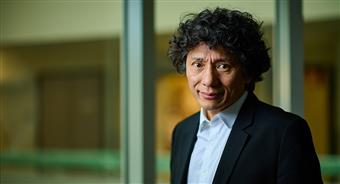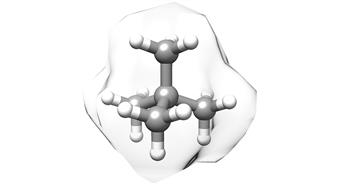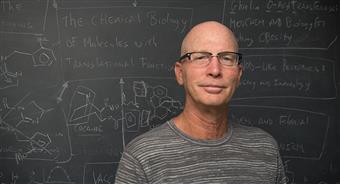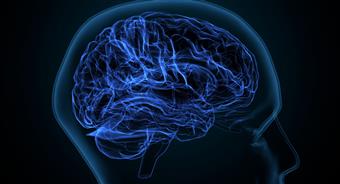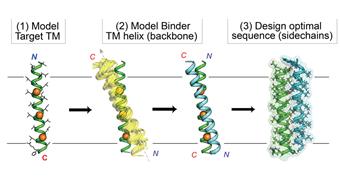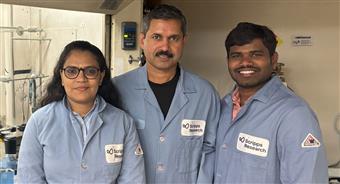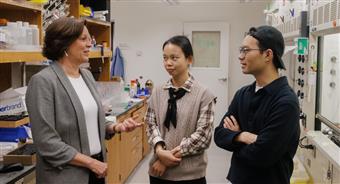
Electrochemistry breakthrough simplifies creation of coveted molecules needed for drugs, electronics New method for making hindered ethers significantly improves production yield while reducing expense and reaction steps
September 09, 2019
LA JOLLA, CA A new chemistry method from scientists at Scripps Research greatly simplifies the creation of an important class of compounds called hindered ethers, which are integral to many drugs and commercial products. Hindered ethers are often coveted for their special properties, but until now have required laborious methods to synthesize.
The new method, reported in Nature, may also help bring electrochemistry into the mainstream of modern medicinal chemistry.
Electrochemistry involves passing a current through a compound in liquid solution to generate a key reactive component. Traditional electrochemistry techniques are often very limited in their scope, but the Scripps Research scientists demonstrated the broad versatility of their technique by showing that it can perform faster, higher-yield syntheses of dozens of hindered ethers used in products today.
These are compounds that historically have required more than a dozen steps and more than a week of work to synthesize using standard methods, says Phil Baran, PhD, the Darlene Shiley Chair in Chemistry at Scripps Research and senior author of the study. With our method, the compounds can be made in just a few steps often in less than a day and for that reason, drug companies that know of this new method already have started using it.
Hindered ethers are particularly prized as structures in medicines because they can be made to powerfully resist enzymes in the human body that would otherwise degrade the drug molecules quickly. Yet the standard approach to creating ethers, a 168-year-old process known as the Williamson ether synthesis, becomes unwieldy when the desired ether includes bulky side-groups of atoms. These atoms can hinder the ether's reactivity (thus, the term hindered ).
Baran and his team in recent years began exploring new electrochemical methods with the hope of improving upon this old, yet somewhat neglected, realm of chemistry to create valuable molecules that were otherwise hard or impossible to make. To address the problem of synthesizing hindered ethers, they investigated a little-used electrochemical method called the Hofer-Moest reaction, first published in 1902.
This method can generate an important reactive intermediate molecule known as a carbocation ( carbo-cat-ion ) needed for ether synthesis from an inexpensive carboxylic acid. However, this method requires a high electric current and an expensive setup, including platinum electrodes. These and other factors have severely limited this reaction's utility. Over the course of hundreds of experiments, Baran and his team developed their own easier and more versatile technique, which uses a low electric current compatible with the simplest electrochemistry equipment, a cheap carbon electrode, and improved solvents and electrolytes.
In their paper, Baran and his colleagues describe more than 80 examples of hindered ethers they were able to create using the new method. These include:
A key building-block of a potential cancer drug, which the team synthesized in just 15 hours with a yield of 51 percent, compared with six days and 3.4 percent yield for the standard method;
A key building-block of a potential diabetes drug, which the team synthesized in three hours in a single step, compared with 2.5 days and five steps for the previous method;
A key building-block of a potential HIV drug, which the team synthesized cheaply with one step in three hours, compared with six steps and two days, with a requirement for expensive reaction materials, for the previous method;
A key building-block of liquid crystals used in LCD monitors, which the team made in one step in three hours, compared with four steps in two days for the previous method. LCD technology is widely used in products such as laptops, flat-screen TVs, digital cameras and watches.
In a selection of these and eight other real-world examples, the team found that the new method enabled an average yield of 43 percent, average step count of 1.5 and average time of 9.8 hours, compared with averages of 19 percent, 6.3 steps and about 100 hours using previous methods.
These are compounds that we know people care about and are making, so we expect this method to have a real impact, Baran says.
He notes that the new method can be used at small or modest scales for example, for the exploratory chemistry of drug discovery but also for large-scale chemical production. Additionally, the method makes it easy for medicinal chemists to generate sets or libraries of closely related compounds; they can use the same basic setup and starting compound, and simply vary some of the reaction ingredients. The study was a collaboration with the laboratory of Donna Blackmond, PhD, professor and co-chair of chemistry at Scripps Research.
The contributions from Donna and her students were critical in helping us develop this chemistry, Baran says. They elucidated a molecular understanding of each of the processes occurring in the reaction flask, so we could rationally optimize the new method.
Baran and his team are now exploring other potential applications of their method.
Its ability to generate highly reactive carbocations under mild conditions suggests that we might be able to use it to make other classes of molecules that were previously inaccessible, Baran says.
The authors of the study, Hindered Dialkyl Ether Synthesis with Electrogenerated Carbocations, include Jinbao Xiang, Ming Shang, Yu Kawamata, Helena Lundberg, Solomon Reisberg, Miao Chen, Pavel Mykhailiuk, Donna Blackmond, and Phil Baran, all of Scripps Research; Gregory Beutner of Brist
More from Scripps
20/04/2024
New copper-catalyzed C-H activation strategy from Scripps Research Two-mode reactions inspired by human detox enzymes offer powerful new tools for drug discover...
12/04/2024
Scripps Research chemists devise easier new method for making a common type of building block for drugs Scientists transform simple linear amines into saturated...
06/04/2024
A simple, inexpensive way to make carbon atoms bind together A Scripps Research team uncovers a cost-effective method for producing quaternary carbon molecules,...
04/04/2024
Developing a vaccine for the zombie drug xylazine Scripps Research chemical biologists design an early proof-of-concept vaccine that could lead to the first...
30/03/2024
How blocking a neural receptor responsible for addiction could reduce alcohol use A Scripps Research team found that a new therapeutic that targets the kappa op...
13/03/2024
New computational strategy boosts the ability of drug designers to target proteins inside the membrane Customized-design approach could streamline the design of...
29/02/2024
Scripps Research scientists reveal how first cells could have formed on Earth New phospholipid discovery brings researchers closer to understanding how primordi...
29/02/2024
How molecular handedness emerged in early biology Scripps Research chemists fill a major gap in origin-of-life theories.
February 28, 2024
LA JOLLA, CA Mole...
22/02/2024
Snaking toward a universal antivenom Scripps Research scientists discovered antibodies that protect against a host of lethal snake venoms.
February 21, 2024
...
06/02/2024
Calibr-Skaggs announces expansion of option and license agreement with AbbVie to develop novel cell therapies for solid tumors and autoimmune diseases
AbbVie...
26/01/2024
Re-energizing mitochondria to treat Alzheimer's disease Scripps Research team restored neuron-to-neuron connections in human cells.
January 25, 2024
LA JO...
24/01/2024
100 years of Science Changing Life: Scripps Research celebrates a century of transforming human health For the last century, institute leaders and renowned scie...
23/01/2024
New technology lets researchers track brain cells' off switches The method could shed light on what goes awry in numerous brain conditions when neurons ar...
09/01/2024
Three decades of giving: Announcing the Calibr-Skaggs Institute for Innovative Medicines The ALSAM Foundation, founded by the Skaggs family, provides lasting g...
04/01/2024
Life science entrepreneur Gene Lay joins Scripps Research Board of Directors Lay, founder of the global biotech company BioLegend, brings invaluable experience ...
21/12/2023
Taming a plant-derived toxin Scripps Research team modifies the traditional poison picrotoxinin for potential neurological drugs and anti-parasite treatments. ...
19/12/2023
Scripps Research Executive Vice President Eric Topol gives TED talk on transformative power of AI in medicine Topol provides an overview of how AI models can i...
13/12/2023
New AI-powered algorithm could better assess people's risk of common heart condition Early detection of atrial fibrillation can reduce the risk of stroke an...
07/12/2023
Nanoparticle flu vaccine design shows promise in early tests Scripps Research-designed vaccine could provide broad, enduring protection against influenza A str...
16/11/2023
Numerous Scripps Research scientists named Highly Cited Researchers Clarivate's annual, global list represents researchers who have demonstrated significant...
07/11/2023
Multiple sclerosis drug invented at Scripps Research slows long-term devastating disease progression Late-breaking data reinforces the effectiveness and safety ...
05/10/2023
Keren Lasker named a 2023 Moore Inventor Fellow The prestigious award will support Lasker's inventive research in membraneless organelles and their applica...
22/09/2023
Michael Bollong named a 2023 Amgen Young Investigator The prestigious award will support Bollong's research identifying new molecular targets and therapeuti...
09/09/2023
Philip Dawson receives 2024 American Chemical Society National Award Dawson is honored with the Arthur C. Cope Late Careers Scholar Award for his foundational c...
07/09/2023
Scripps Research chemists devise a method for C-H activation of alcohols The method represents a new toolkit for making drugs and other compounds.
September 06...
31/08/2023
Scripps Research receives $1.5M to surveil infectious disease threats in wastewater Bill & Melinda Gates Foundation award to support the development of multi-pa...
16/08/2023
How cold temperatures trigger the brain to boost appetite Scripps Research scientists' discovery could lead to new weight loss and metabolic health treatmen...
08/08/2023
Human antibody that targets carfentanil, fentanyl and related opioids reverses overdose effects in preclinical study Scripps Research-developed antibody therapy...
04/08/2023
How sensory neurons impact the gut Scripps Research scientists show that the receptor PIEZO2 in sensory neurons controls gut motility and transit time, which a...
26/07/2023
AbbVie and Calibr Expand Strategic Collaboration to Advance Several Preclinical and Early-stage Clinical Assets The expanded strategic collaboration will advan...
23/07/2023
Scripps Research scientists develop AI-based tracking and early-warning system for viral pandemics Machine-learning system effectively predicts emergence of pro...
19/07/2023
Monitoring T cells may allow prevention of type 1 diabetes Scripps Research study shows that analyzing T cells in blood samples could be used to select at-risk ...
19/07/2023
Scripps Research mourns passing of leading organic chemist Albert Eschenmoser Eschenmoser pioneered key reactions in synthetic chemistry and shaped the understa...
15/06/2023
Scripps Research awarded $46.8 million by NIH to promote human health through innovative translational science and training The Translational Institute is harne...
13/06/2023
Scripps Research's Danielle Grotjahn named 2023 Pew Scholar in the Biomedical Sciences The award will support Grotjahn's study of how cells assemble the...
31/05/2023
Crossing the ring: new method enables C-H activation across saturated carbocycles Scripps Research chemists add another powerful tool to their molecular editin...
24/05/2023
Scripps Research develops behind-the-scenes tool for better biomedical data discovery The new resource makes datasets more discoverable for life science communi...
19/05/2023
Scripps Research neuroscientist Hollis Cline elected to American Academy of Arts and Sciences Cline is recognized for her discoveries about the role of sensory ...
19/05/2023
Scripps Research's Skaggs Graduate School awards doctoral degrees to 31st graduating class Commencement ceremony will be livestreamed via Zoom and on instit...
13/05/2023
A better route to benzocyclobutenes, sought-after building blocks for drugs Scripps Research chemists devise a new, C-H activation-based method for the synthesi...
09/05/2023
Renowned Scripps Research professor Jeffery Kelly elected to National Academy of Sciences Kelly's groundbreaking work on protein misfolding has led to thera...
28/04/2023
Mirror-image molecules pave new path for cancer drug discovery By comparing how mirror image versions of small molecules impact clusters of proteins, Scripps R...
22/04/2023
How alcohol consumption contributes to chronic pain A Scripps Research team showed how both alcohol intake and alcohol withdrawal can lead to increased pain and...
21/04/2023
Xin Jin receives dual awards to study autism risk genes in neurodevelopment Major grants from the National Institutes of Health and California Institute for Reg...
20/04/2023
Trim the sugar: New HIV vaccine design improves immune response Scripps Research vaccine candidate headed for clinical trials.
April 19, 2023
LA JOLLA, CA A...
18/04/2023
Therapeutic can seek and destroy potent opioid to treat overdoses Scripps Research chemists developed a new biologic to work against the synthetic opioid carfen...
07/03/2023
How heavy alcohol consumption increases brain inflammation The findings by a Scripps Research team point toward a potential new drug target for treating alcohol...
02/03/2023
Scientists find human antibodies that can block multiple coronaviruses including SARS-CoV-2 Results from a Scripps Research and UNC team pave the way for a vacc...
28/02/2023
$10 million grant funds Scripps Research Alcohol Research Center through its 50th year The five-year grant supports research into the neurobiology of alcohol us...
28/02/2023
Immune system drug shows promise in treating alcohol use disorder, a Scripps Research clinical trial reports Scientists at Scripps Research found that apremilas...
 Electrochemistry breakthrough simplifies creation of coveted molecules needed for drugs, electronics New method for making hindered ethers significantly improves production yield while reducing expense and reaction steps
Electrochemistry breakthrough simplifies creation of coveted molecules needed for drugs, electronics New method for making hindered ethers significantly improves production yield while reducing expense and reaction steps














